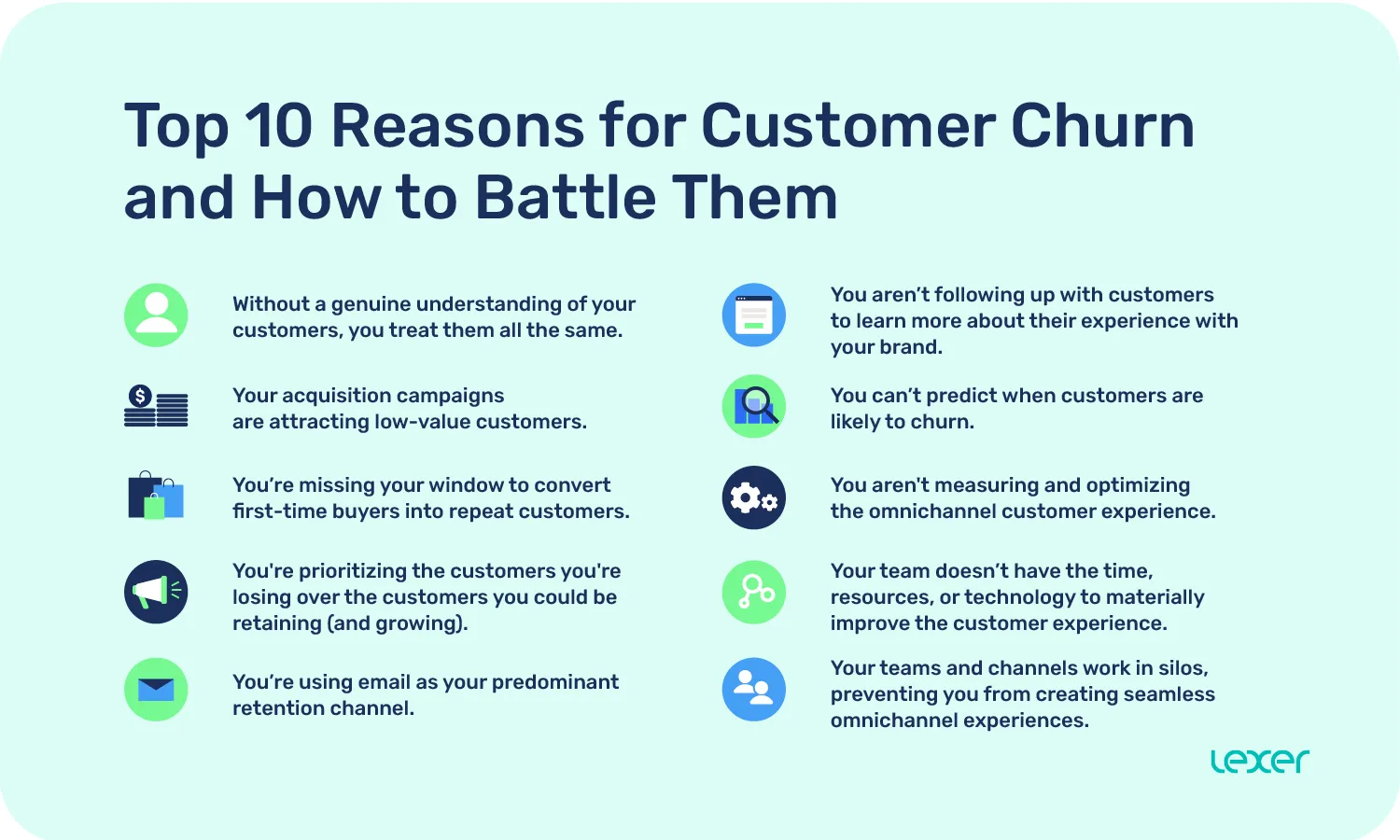July 5, 2021
Top 10 Reasons for Customer Churn and How to Battle Them
As retail competition increases, high customer churn may be one of the most pressing challenges you’ll face. Predicting and preventing churn before it occurs will help you defend your market share and grow the lifetime value of your existing customer base. This article explores the top reasons for customer churn and provides data-driven solutions for reducing it.

Customer churn, also known as customer attrition, is often a signal that something has gone wrong with the customer experience.
All customers churn eventually—whether it’s days or decades after their first purchase—but abnormally high churn rates can compound the customer experience challenges you might already be facing.
When customers leave, your focus goes toward acquiring new customers to make up for lost revenue. You have less time and fewer resources to dedicate to customer service, product development, marketing optimization, and other high-impact areas of your business. Not to mention, it’s exponentially more expensive to acquire new customers than it is to retain them.
Luckily, customer experience and analytics platforms like Lexer can help you easily identify the major causes of customer churn and take action to retain customers. Based on the ongoing customer churn analysis we do for our retail clients, here are the 10 most common causes of churn and strategies for reducing them.
Top 10 reasons for customer churn and how to battle them
1. Without a genuine understanding of your customers, you treat them all the same.
Your customers expect seamless and personalized experiences no matter where and how they engage with your brand. If you aren’t meeting that expectation, your customers will leave to find another brand that will.
THE SOLUTION: Use data to create relevant and actionable customer personas.
Before you send another batch-and-blast email, use your data to analyze, segment, and understand your current customer base. Information such as demographics, lifetime value, purchase history, and channel preferences can help you identify clear segments within your existing customers. Personalizing your marketing campaigns to each segment can help you provide a better overall customer experience, effectively reducing churn.
Learn more: Creating Data-Defined Customer Personas.
2. Your acquisition campaigns are attracting low-value customers.
When you’re losing customers faster than you can acquire them, you might be compelled to double-down on your acquisition activities to replace those customers. However, targeting too broad an audience in your acquisition campaigns can actually contribute to high churn rates by attracting poor-fit prospective customers.
THE SOLUTION: Use advanced audience segmentation to build high-value lookalike audiences.
Instead of building lookalike audiences based on your entire customer base (including low-value, infrequent, and churned customers), focus your acquisition audiences to only target prospects who look like your highest-value customers. Although this strategy may narrow your initial audiences, it will increase your impact by reducing acquisition costs and attracting more valuable customers who are less likely to churn.
Learn more: 4 Steps to Acquiring High-Value Customers.
3. You’re missing your window to convert first-time buyers into repeat customers.
Two-time buyers are 9x more likely to make additional purchases than one-time buyers—which means that the most critical milestone for preventing churn is the second sale. However, the second sale is also the most time-sensitive, requiring focused targeting soon after the first sale while your brand is still top-of-mind. If you fail to effectively communicate with your new customers during this time period, you could be missing the opportunity to solidify a long-term relationship with those customers.
THE SOLUTION: Maximize the second conversion with a timely and targeted cross-sell strategy.
Use your customer data to analyze the average time between the first and second purchase for your high-value customers. If your highest-value customers tend to make their second purchase within 90 days or less of their first, your cross-sell targeting will need to begin very soon after that initial purchase. On the other hand, slow repurchase rates may require a longer-term, multi-touch approach to driving the second sale. Either way, automating this outreach to send at the optimal time can prevent a high-value evangelist from slipping through the cracks as a churned customer.
Learn more: A Practical Guide to Driving the Second Sale.
4. You're prioritizing the customers you're losing over the customers you could be retaining (and growing).
Although it’s frustrating to see any customer churn, you don’t have to retain every customer to maintain a robust and active customer base with healthy revenue growth. Low-value customers aren’t always worth including in retention campaigns, because the cost of retargeting these customers may be higher than the actual value they’ll provide to your business.
THE SOLUTION: Identify your high-value customers and then proactively engage with them to add special value and boost conversions.
Instead of trying to retain every customer, funnel your churn prevention efforts into your highest-value customers. One strategy for doing so is proactive clienteling. By identifying high-value customers in your database and proactively contacting them about discounts, events, product maintenance, or other relevant information, you can streamline the customer experience and maximize retention.
Learn more: Clienteling.
5. You’re using email as your predominant retention channel.
Email win-back campaigns are a popular strategy for re-engaging lapsed customers before they churn. However, it’s common for more than 66% of lapsed customers to have opted-out of email. If you’re only using email for your re-engagement campaigns, then you’re missing out on the potential to prevent churn for 66% of your lapsed customer base.
THE SOLUTION: Segment lapsed customers by channel addressability and target them across paid and email to increase reach.
Instead of relying on email alone, target lapsed customers across both email and paid channels to increase reach and impact. Using customer analytics and cross-channel activation tools, identify your lapsed customers, segment these customers by email engagement status, and serve personalized win-back campaigns via the channels they’re most likely to engage with.
Read a case study: Black Diamond increases email conversion rates by 555%, boosts revenue per email by 1,101%, and drives a 4.48 return-on-ad-spend using Facebook advertising.
6. You aren’t following up with customers to learn more about their experience with your brand.
Customers churn for a variety of reasons: Confusing website navigation, poor in-store experiences, product defects, price points outside of their budgets, or simply outgrowing their need for your products. Most businesses use NPS surveys to understand how many of their customers are satisfied and dissatisfied with their overall experience, but negative NPS scores alone don’t tell you the specific reasons for customers churning.
THE SOLUTION: Augment your NPS surveys to understand the differences in attitudes, preferences, and behaviors between promoters and detractors.
The next time you send an NPS survey, include follow-up questions that dig deeper into the reasons behind the NPS scores. When survey responses are immediately unified to customer profiles in a single customer view, you can easily analyze how promoters and detractors differ by lifetime value, channel preferences, return rates, products and categories purchased, and other key customer metrics. These insights will help you discover (and reduce) the factors contributing to your high churn rates.
Learn more: Unpacking Customer Preferences, Behaviors, and Attitudes by Augmenting NPS Surveys.
7. You can’t predict when customers are likely to churn.
Customer churn prediction for the retail industry can be complicated, because retail consumers tend to go through a “cool down” period before fully churning. During this cool-down period, it’s still possible to win those customers back with targeted outreach—but if you can’t predict churn ahead of time, you might wait too long to send this outreach, missing your final window for re-engagement.
THE SOLUTION: Improve your analytics maturity to predict churn and intervene before it’s too late.
In order to predict and prevent churn, you need the ability to identify early indicators of churn, calculate churn risk ahead of time, and send personalized win-back campaigns to high-risk customer segments. This predictive ability requires unified customer data, advanced analytics tools, and artificial intelligence.
Learn more: Where Does Your Business Fall On the Customer Analytics Maturity Curve?
8. You aren't measuring and optimizing the omnichannel customer experience.
You’ve probably heard the maxim, “you can’t improve what you can’t measure.” This certainly holds true for the omnichannel customer experience. Modern consumers engage with their favorite brands across a variety of sales and marketing channels, and they expect brand experiences to remain consistent and high-quality no matter where they shop. However, if you’re still using channel-based tools and datasets that don’t speak to each other, it can be difficult to understand the totality of the omnichannel experience you’re providing.
THE SOLUTION: Track key omnichannel metrics to understand and maintain a consistent customer experience across channels.
To improve the omnichannel customer experience, you need to understand how customer behavior compares and contrasts across each channel. Tracking omnichannel metrics such as customer lifetime value, recency and repurchase rates, customer satisfaction, ticket volume, and customer profitability can help you gain deeper insight into your customers’ omnichannel relationship with your brand.
Learn more: 5 Omnichannel Metrics Every Customer-First Brand Should Measure.
9. Your team doesn’t have the time, resources, or technology to materially improve the customer experience.
Once you’ve determined why your customers churn and how to prevent it, you need to act on those insights. But small teams often struggle to take those actions, forced into reactive, inefficient processes due to a lack of resources. Without the right tools and expertise, effectively executing strategies to improve the customer experience can be frustrating and costly in both time and budget. When you’re too slow to improve, customers move on.
THE SOLUTION: Use a CDP to set up automated, insight-driven customer journeys to save time and maximize impact.
Customer Data Platforms (CDPs) like Lexer act as the all-in-one solution for understanding and improving the customer experience. With the ability to draw customer insights, build segments, automate cross-channel campaigns, and measure performance from just one tool, you can quickly scale your impact without stretching your team’s budget or capacity.
Learn more: 7 Foundational, Insight-Led Customer Journeys for Every Lifecycle Stage.
10. Your teams and channels work in silos, preventing you from creating seamless omnichannel experiences.
In the past, channel-centric tools, teams, and operations were the norm. However, the rise of digital led to an increased focus on relevant, real-time, frictionless, and omnichannel customer experiences—and channel-centric businesses have struggled to adapt. When data is kept in siloed systems that don’t speak to each other, it’s difficult to understand your true relationship with customers and personalize their experiences across channels.
THE SOLUTION: Reorient your business and your data around the customer to drive customer-led innovation.
By taking a customer-centric approach to managing, interpreting, and activating your data, you can ensure that the same customers receive the same quality of service across every channel and touchpoint. With all teams aligned around a single customer dataset, you can seamlessly orchestrate engaging customer experiences across channels and teams.
Learn more: Moving From Channel-Led to Customer-Centric.
The best defense against churn? Know your customers
Almost always, a high customer churn rate stems from the same underlying issue: You don’t know your customers well enough.
By combining, standardizing, and enriching your data into a single customer view, you can gain in-depth insights that transform the way you engage with customers. With a better understanding of your customers, you can improve the customer experience, reduce churn, and increase lifetime value.
Lexer’s CDP cleanses and combines data into an enriched single view of the customer with one of the simplest onboarding processes in the industry. Our intuitive tools enable retail, marketing, and service teams to draw meaningful conclusions from data in ways previously reserved for experienced data scientists. More than a vendor, Lexer’s dedicated Success team teaches proven, data-driven engagement strategies that empower all teams to positively impact every stage of the customer lifecycle.
Lexer’s CDP can help you prevent churn and maintain profitable relationships with your most valuable customers. Use the meeting link below to book a demo.
Speak with our retail experts

